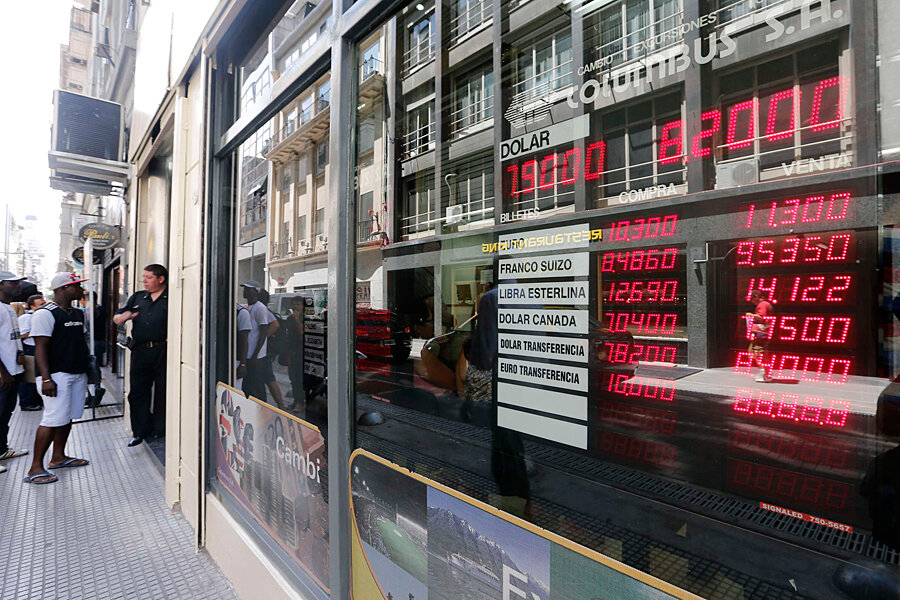As Argentina's currency plunges, echoes of past financial crises
Loading...
| Buenos Aires
After a tumultuous week of monetary backtracks and a currency devaluation, Argentines awoke Monday to more economic uncertainty.
The government today announced how it will implement new rules on dollar purchases, a measure that follows its decision to allow the peso to plunge. It claims the moves are astute reactions to “speculative attacks” on Argentina's economy by destabilizing forces. But analysts argue they are haphazard and foster uncertainty in a country with a history of financial mismanagement and inflationary spirals, including a debilitating crisis in 2001-02.
“These decisions create more doubt than certainty,” Guillermo Nielsen, a former finance secretary, wrote in a financial newspaper. “The government is very disoriented.”
A tumbling currency
The peso tumbled by 15 percent against the dollar in just three days last week, according to Bloomberg, including a drop of 9.5 percent on Thursday, the biggest since 2002, when Argentina's previous dollar peg collapsed.
Last week's devaluation followed a policy shift by Argentina's central bank, which was trying to execute a quick depreciation of the peso but ran into difficulties over its shrinking dollar reserves, which recently touched a seven-year low of around $29 billion. Locked out of global financial markets, the government needs the reserves to pay for energy imports and foreign debt servicing. So the central bank kept hold of its dollars and let the peso dive.
In a move that surprised many observers, on Friday the government chose to ease currency controls aimed at curbing capital flight that date back to President Cristina Fernández de Kirchner's reelection in October 2011.
The government hopes the measure will reduce the gap between the official dollar exchange rate, which closed on Friday at eight pesos, and the black-market rate that hit a peak last Thursday of 13 pesos. Under the new rules, Argentines can now buy dollars to save, but the federal tax agency is expected to keep a tight control over these purchases in order to shore up the dollar reserves.
'A lost battle?'
Still, analysts say the government needs to accompany its change in currency policy with tougher action on unofficial inflation, which is estimated to exceed 28 percent.
“There could be a spiral of devaluation and inflation,” says Gastón Rossi, a former deputy economy minister under President Kirchner. “The government can confront that with a credible plan, reducing its spending and raising interest rates.”
Some people here believe Kirchner and her aides are close to losing control of the economy. “It’s not the apocalypse yet, but we're not in a good place,” says Santiago Sasso, an office worker. “I don't have faith in the government. It's a lost battle.”
Axel Kicillof, the economy minister, insisted in an interview published Sunday that the government has a firm grip on the situation. “The economic panorama is very calm,” Mr. Kicillof said. He accused Argentina's media – with whom the Kirchner government has long been at odds – of trying to fuel a run on the peso.
On Friday, he claimed a “speculative attack” by Shell, the oil company, had contributed to the peso’s dive. “The large and concentrated financial sectors have a lot of experience in destabilization,” Kicillof said. “But we have the tools to face up to them.”
The tumult has thrown a spotlight on Kicillof, a former university professor known for his Marxist interpretations of economic theory. He took up his post in November as part of a cabinet reshuffle that was supposed to favor pragmatists. But his management of the economy is now being widely criticized.
He also lashed out at reporters on Friday in a curt televised comment that showed the strains on an administration, which, commentators wrote in an anti-government newspaper, is facing a crisis of leadership and communication. “It was impulsive,” says Mr. Rossi. “It doesn’t send a message of calm.”








